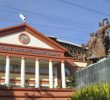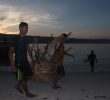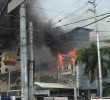Southern Mindanao offers abundant resources and a resilient people. According to business leaaders, it holds so much promise of progress. But the region is also a land wracked by decades of inequality and conflict.
By Gilbert Pacificar
davaotoday.com
DAVAO CITY – The Davao region – also known as Region 11 or Southern Mindanao Region — is divided into four provinces, the largest of which is Davao Oriental, then Compostela Valley, Davao del Sur and Davao del Norte.
There are five cities in the region: Panabo, Island Garden City of Samal, and Tagum cities, which are in Davao del Norte while Digos City is in Davao del Sur.
The region’s urban center, Davao City, is one of the largest cities in the world in terms of land area.
At the northern portion of the province are the adjoining provinces of Compostela Valley, Davao del Norte and Davao Oriental. The only province to the south of Davao City is Davao del Sur.
Davao region’s total land area of 2,714,059 hectares is predominantly mountainous and marked with valleys and hills. The region’s highest mountain range, Mount Apo, is also the highest peak in the country.
The region’s population reached more than 5 million as of year 2000, based on the survey of the National Statistics Office (NSO).
The various ethno-linguistic groups in the country are represented here, as a result of the waves of migration that began before World War II.
From Luzon came the Ilocanos, the Kapampangans and Tagalogs, the Cavite�os, Batangue�os and Bicolanos. From the Visayas came the Ilongos, Negrenses, Cebuanos, Boholanos and Leyte�os.
Many parts of the region are home to indigenous peoples whose culture are as distinct and as truly multi-hued as the clothes they still use to this day.
As described in Ernesto Corcino’s book, “Davao: An Introduction to History,” the tribes that could be found in the north are the Atas inhabiting the hinterland portions west of Davao del Norte, the Mansakas [[,]] Manobos and Dibabawons in the uplands of Compostela Valley Province and the Mandayas in Davao Oriental.
There are also Muslim tribes inhabiting the shores and mouths of rivers in Davao del Norte. To the south, down to the places that surround the approaches to Mount Apo in Davao del Sur, are the Bagobos and their tribe’s various sub-groups.
These peoples are still very much around, albeit struggling for continued existence and self-determination in their ancestral lands.
The lifeblood of the region’s economy is agribusiness, mining and tourism, according to Romeo Serra, vice-chairman of the Mindanao Business Council and immediate past president of the Davao City Chamber of Commerce and Industry.
According to him, the vast economic potential of the region lies in its vast tracts of agricultural lands, its mineral reserves and its natural attractions that make for good tourism business.
These types of businesses, which are attractive to investors, are key to realizing the dream of making the region the premier economy and the gateway to Mindanao, Serra said. As of last year, the gross regional domestic product of the region stood at more than 51 billion pesos.
Among the investment come-ons is the mild and tropical climate that is typhoon-free, the growth of infrastructure support facilities for industries, such as the Davao International Airport and the major seaports and piers in the city as well as in Mati, in Davao Oriental, and Madaum and Panabo, in Davao del Norte.
Despite the rosy economy picture, however, most families in the region live in poverty. The minimum daily wage remains at 209 pesos, which is not even half of the 555 pesos that a family of five needs every day in order to survive decently.
The unemployment rate is one of the highest in the country, at 9.2 percent as of July 2005, according to government data.
The problem of landlessness is still prevalent in the region even as vast tracts of lands are converted into large plantations.
The indigenous people and peasants here are still clamoring for land to till. In fact, many of the indigenous peoples are struggling, and some of them have even took up arms, in defense of their ancestral lands, which are being aggressively pursued by private mining and logging companies, commercial plantations and power generation companies.
The woes of small farmers in the region are plenty. Aside from the fact that there are hardly any facilities accessible to farmers, they are heavily burdened by the increasing cost of farm inputs, like pesticides and fertilizers, Amancio Carmello, the spokesperson in the region of the farmers organization Kilusang Magbubukid ng Pilipinas.
To add insult to injury, Carmello said compradors or traders also make a killing from their control, manipulation and even distortion of farmgate prices of rice, corn and coconut, which are exploitatively low. Because of this, he said, farmers are hardly able to buy the food to they need to muster strength to till their land.
Even small farm owners in the region are also complaining of the aggressive expansion of commercial plantations, especially for banana.
At the same time demolitions are common in urban areas as more land are being taken away by private owners who usually convert these into office buildings, housing subdivisions, even eco-tourism spots such as nature parks.
There is a big disparity, meanwhile, in the distribution of wealth and in income. Based on government data in 2000, only 31 percent of families in the region earn between 8,000 and 20,000 pesos or above per month. The rest earn from a low of 1,600 pesos a month to a high of 8,300.
The exploitative working conditions in the large mining industries, manufacturing, and even in the retail trade business and other service sectors contribute to the hardship, according to labor groups.
These issues of oppression breed unrest, which worsen the decades-old war between the government and the communist New People’s Army. As such, armed conflict is a reality in the region.
In response, the government has unleashed large combat forces in the various provinces of the region to fight the New People’s Army and the Moro Islamic Liberation Front. At present, data from the human-rights alliance Karapatan said there are nine battalions of government troops throughout the four provinces in the region.
A consequence of the escalation of conflict are the human-rights atrocities that usually victimized peasants and indigenous peoples, according to Karapatan. (Gilbert Pacificar/davaotoday.com)










